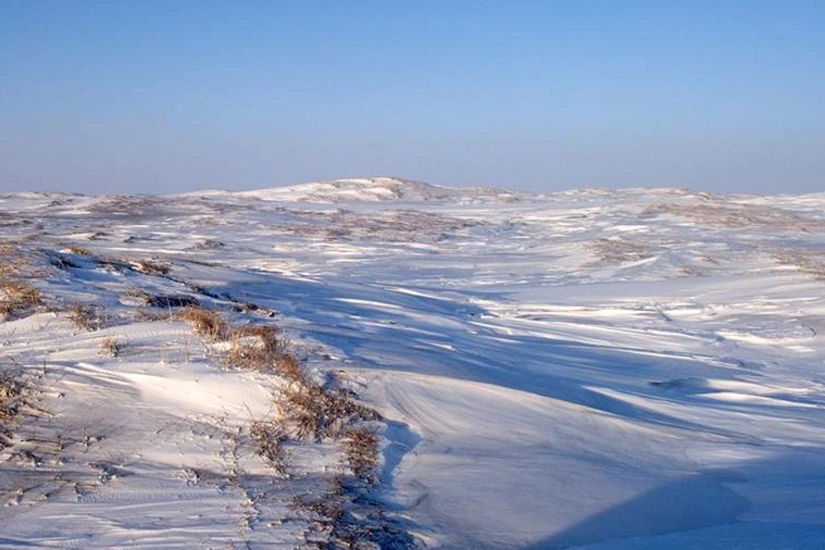Arctic suffers hottest summer on record: NOAA
- 14 December, 2023
- 04:38

The Arctic experienced its warmest summer on record in 2023, with an average temperature of 6.4C (43.5F) — half a degree higher than the previous record set in 2016, according to the Arctic Report Card, Report informs via Bloomberg.
Coming at the end of the hottest year ever recorded, the 18th edition of the annual report shows a continuation — and in some cases an acceleration — of trends that are reshaping the polar region as the planet heats up from human-caused climate change. Those trends include less sea ice, more rain and warmer sea surface temperatures.
“By no means is this normal,” said Paul Overduin, a geoscientist at the Alfred Wegener Institute Helmholtz Centre for Polar and Marine Research in Germany, who contributed to the report card from the US National Oceanic and Atmospheric Administration. “It’s not just that the summer itself is changing. The spring is coming earlier, the fall is coming later, so summer’s kind of taking over, and the Arctic is losing its winter at some point down the road. And the question is, what will that do, and what will that look like?”
Already, ice loss in near-surface permafrost is triggering landslides and slumping that’s pouring material into rivers, lakes and Arctic seas.
“There are places where you look at the landscape — the Canadian Arctic Archipelago, for example, or also in Western Siberia — where it looks like the surface of the Earth has a disease,” Overduin said. “The entire landscape is in motion. This is just really in the last five years.”
NOAA tracks eight different “vital signs” for Arctic health in the report card. Among the key findings this year:
In addition to the hottest summer on record, the Arctic saw its sixth warmest year since record-keeping began in 1900, with an average surface air temperature of -6.9C, 0.7C higher than the 1991-2020 average. Since 1940, annual average temperatures have risen a quarter of a degree Celsius per decade. Higher temperatures on land can warm major rivers that drain into Arctic seas, raising those surface temperatures and melting sea ice.
Sea ice coverage continues to shrink — meaning so does the planet’s reflective shield. This year’s sea ice extent was the sixth lowest since satellite records began in 1979. The 17 lowest Arctic sea ice extents on record occurred in the last 17 years.
Sea surface temperatures in the Arctic in August were 5C to 7C warmer than the 1991-2020 mean values in the Barents, Kara, Laptev and Beaufort seas, while unusually cool temperatures were seen in Baffin Bay, the Greenland Sea and parts of the Chukchi Sea.
The Arctic is getting greener. Tundra greenness was the third highest in 24 years of satellite records. As sea ice melts earlier in the spring, warmer exposed water creates a more moderate, maritime climate in coastal areas. That leads to the growth of more biomass — including shrubs and small trees — on land that was mainly covered by lichen. That has knock-on effects that are not yet fully understood, said Uma Bhatt, a professor of atmospheric sciences at the University of Alaska Fairbanks, who contributed to the report card. It could affect the food chain and the Indigenous communities that rely on animals like caribou, which eat lichen.
Much of the Arctic is seeing an increase in marine algae, with the biggest phytoplankton bloom occurring in the Eurasian Arctic and Barents Sea linked to warmer temperatures. Harmful algal blooms are an emerging threat to human and ecosystem health, the report states.
North American snow cover set a record low in May, but overall snow accumulation was above average across the continent and Eurasia during winter 2022-2023. Snow can help mitigate mass loss from the Greenland ice sheet.
Despite that higher-than-average snow accumulation, the Greenland ice sheet continued to lose mass. The highest point of the ice sheet was above freezing on June 26, 2023, only the fifth time in 34 years of records this has happened. Were it to melt entirely, scientists estimate that global sea levels would rise about 7.4 meters (23 feet).
The Arctic continues to get wetter, with pan-Arctic precipitation the sixth highest on record in 2023. But Northern Canada experienced an abnormally dry summer, contributing to record wildfire conditions already stoked by the longer-term warming trend. As of late October, 4.61 million hectares of forest had burned in high-latitude North America, releasing devastating levels of greenhouse gases.
Anomalies within the longer-term warming trends, such as the cool sea temperatures observed in some locations, are the inevitable result of complex systems interacting and changing rapidly. While these can have severe local consequences of their own, from freak storms to see-sawing fish populations, the report notes that the overarching trend of a warming Arctic is contributing to “high impact” events, such as this summer’s record wildfires in Canada, through cascading environmental effects.
The report also flags the role of Indigenous communities in mitigating damaging impacts of climate change, as well as areas where more research is urgently needed. Among these is subsea permafrost: permafrost that began on land but was covered by rising seas about 18,000 years ago. Some scientists believe it may play a significant role in carbon sequestration, because of both the amount of methane frozen within it and its role as a barrier preventing greenhouse gases below the sea floor from migrating upwards, but there are many unanswered questions.
While highlighting such unknowns, the report also underscores facts that are irrefutable.
“It is getting warmer, it’s getting wetter, the sea ice is declining,” said Bhatt. “We’re seeing consequences of human impact in all of our vital variables.”
